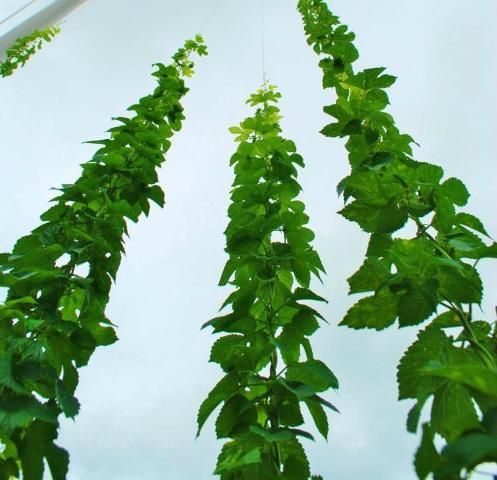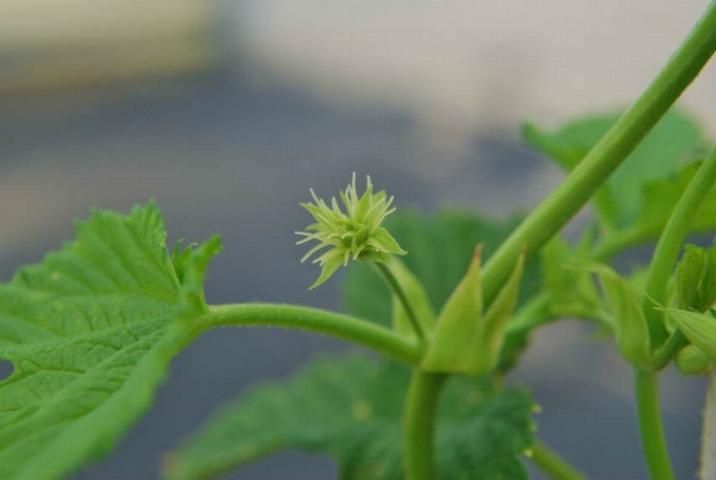Introduction
Hops (Humulus lupulus) are perennial, herbaceous climbing plants commonly cultivated for their strobiles or cones (Figure 1). The cones are often used for flavoring and aroma in food, tea, and beer (Almaguer et al. 2014; Burgess 1964). Hops can make a unique addition to a home garden or landscape. It grows rapidly in the early spring to late summer. Plants reach a mature height of 18–25 feet in one year and produce cones from mid-summer to early fall.

Credit: Brian J. Pearson, UF/IFAS
Common Name
Hops
Scientific Name
Humulus lupulus
Plant Family
Cannabaceae
Outdoor Cultivation Information
USDA Hardiness Zone
Hops prefer USDA Hardiness Zones 4 to 8 (for more information on USDA Hardiness Zones, see https://planthardiness.ars.usda.gov/). Research (Pearson et al. 2016) indicates hops can tolerate zones outside of this range (Zone 9b).
Soil Preference
Hops grow best in well-drained, humus-rich soil with a pH of 6.0–6.5. Soil preparation is important for optimal plant growth. Organic matter, such as composted manure, biosolids, and yard waste, can be amended into the top 4–8 inches of soil using a rototiller, shovel, or spading fork to improve soil characteristics for plant growth.
Light Requirement
Hops require full sun for maximum cone production.
Water Requirement
Irrigate hops regularly, but provide drainage.
Drought Tolerant
Yes. Hops have the ability to tolerate drought.
Fertilizer Requirements
Apply a well-balanced, slow-release pelletized (granular or encapsulated) fertilizer such as Osmocote® or Nutricote® according to manufacturer recommendations during the spring and summer.
Temperature Preference
Although hops prefer a mean annual temperature of 42°F–70°F, they can survive in Florida summers.
Freeze Tolerant (Below 32°F)
No. Hops defoliate in late fall as the plant enters winter dormancy. Plant material should be pruned after defoliation occurs. New shoots will emerge when the plant breaks dormancy in early spring.
Pests/Disease
The following can affect production of hops: mites (Tetranychus urticae), downy mildew (Pseudoperonospora humuli), and powdery mildew (Sphaerotheca humuli) (Mahaffee and Pethybridge 2009). Take a sample to your local UF/IFAS Extension agent to confirm identification and receive treatment instructions; to find your local UF/IFAS Extension office, visit http://sfyl.ifas.ufl.edu/find-your-local-office/.
Origin
Asia, Europe, and North America
Availability
Humulus lupulus rhizomes can be purchased from online and mail order vendors from mid-March through May. Rhizomes should be purchased as early as possible for March/April planting in Florida before temperatures become high. Rhizomes should be placed horizontally or vertically in the soil approximately 1 inch below the surface. Shoots from newly planted rhizomes will emerge within 2–3 weeks after planting.
Notes
Humulus lupulus can be trained on a trellis or twine strung on poles, bars, or fences. Plant growth slows after summer solstice (June 21), and small flowers (Figure 2) begin to emerge from each node approximately 3–4 feet from the soil surface. As flowers mature, they develop into cones (Figure 3) and ripen mid-summer to early fall, depending on the variety. Cones are ripe and optimal for harvest when dry and papery to the touch. For additional information specific to harvesting of hop cones, please refer to EDIS publication ENH1314 Harvest Techniques for Hops (Humulus lupulus). If the cones are not used directly after harvest, they should be air dried, stored in an airtight container, and placed in a freezer until use. For additional information on drying and storing of hop cones, please refer to EDIS publications ENH1304 entitled, Process of Drying Post-Harvest Hops (Humulus lupulus) for Small-Scale Producers Using a Novel Drying Rig, and ENH1297 Packaging and Storage of Hops (Humulus lupulus).

Credit: Brian J. Pearson, UF/IFAS

Credit: Brian J. Pearson, UF/IFAS
References
Almaguer, C., C. Schönberger, M. Gastl, E. K. Arendt, and T. Becker. 2014. "Humulus lupulus – a story that begs to be told: A review." Journal of the Institute of Brewing 120: 289–314.
Burgess, A. 1964. Hops: Botany, Cultivation, and Utilization. New York: Interscience Publishers.
Mahaffee, W., and S. Pethybridge. 2009. "The Genus Humulus." In Compendium of Hop Diseases and Pests, edited by W. F. Mahaffee, S. Pethybridge, and D. H. Gent, 1–5. St. Paul, MN: The American Phytopathological Society.
Pearson, B. J., R. M. Smith, and J. Chen. 2016. "Growth, strobile yield, and quality of four Humulus lupulus varieties cultivated in a protected open-sided greenhouse structure." HortScience 51(7): 838–842.